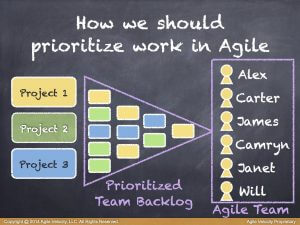Part 6 of 6 in the “Double the Value in Half the Time” series based on David Hawks’ presentation from Keep Austin Agile 2015.
The last problem is this: everything’s important, everything’s high priority, everything must get done.
Well, they may all be important, but executive teams need to understand: you can’t just say everything’s high priority because this happens…
My three favorite ways to prioritize
 We have a set of people for Project 1—I assign it out to Alex, James, and Janet. We get Project 2 and we need Alex, Carter, and Camryn. For Project 3, we need Alex, James, and Will. Anybody see a problem? How do you think Alex is feeling right now? Pretty important. Alex may be thinking “I’m the hero around here” or “I get all the good stuff” or “I have job security”. Because all of these projects are a high priority, all of them are important. So how does Alex decide what to work on next? My three favorite techniques to prioritize:
We have a set of people for Project 1—I assign it out to Alex, James, and Janet. We get Project 2 and we need Alex, Carter, and Camryn. For Project 3, we need Alex, James, and Will. Anybody see a problem? How do you think Alex is feeling right now? Pretty important. Alex may be thinking “I’m the hero around here” or “I get all the good stuff” or “I have job security”. Because all of these projects are a high priority, all of them are important. So how does Alex decide what to work on next? My three favorite techniques to prioritize:
- What’s the coolest?
- Who’s screaming loudest?
- What’s the easiest?
So because the executive team, who make the big bucks, are not deciding the business priorities, the people furthest removed from understanding the business are making decisions based on coolest, easiest and loudest. That’s how our businesses are being run. We’re overloading people because we’re saying everything is a high priority.
How do we solve this in agile?

In this picture, the yellow item in the backlog would be first and then the blue and green and so on. We have a priority list. And then the team will figure out how to divide up the work. The team is self-organizing. If people on the team need to learn some of the skills or knowledge areas that Alex has, then Alex will teach them. And the team will figure it out. The team will adjust. The product owner should create focus for the team because everything can’t be the highest priority.
Tying it all up
There are six issues that are the top problem areas holding most organizations back and they all factor into the notion of the potentially shippable product increment. They’re trying to get something incrementally shippable done. To do that, it requires focus, to break work down and to swarm. They need to be cross-functional and figure out how to work together to get stuff done instead of just working on the things they’re comfortable with. If they can do that, then they can realize some big benefits.
All of these issues tie into the idea of outcome vs output. The goal is not to maximize efficiency, utilization, and output. Instead, the goal is to maximize outcome and value and solve business problems. So when your team gets hung up on “that’s not the most efficient way to work”, it might not be. If you take a bunch of introverts and put them on a team and say you have to work together, they may say “I don’t really like people. I just want to go work in my office by myself. It’ll be more efficient.” Yes, maybe, but it’s not the most effective use of your time to deliver value on the other side.



